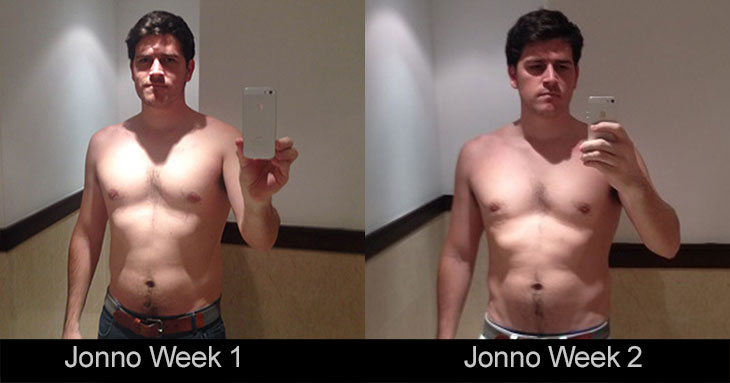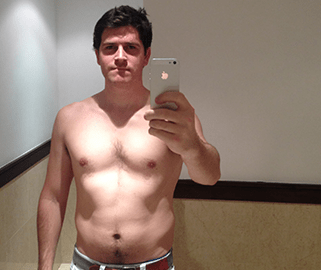Last week I wrote a blog post on how to set goals.
For any of my goals to work, I have to put three basic parameters in place:
The Measureable Achievable – a non-wishy-washy number, event or object that I can see or touch, with a specific cut-off date.
The Reality Chart – a list of stats that relate to my goal, that I will need to reach, in order to achieve the whole goal.
The Summons – something that locks me into my goal. The summons adds stakes to the goal so that if I don’t achieve it, something so bad will happen that the decision to continue pushing for my goal is easier than deciding not to.
The goal I laid out was:
‘The Monday (21 December 2015) before Christmas 2015, I will have a six-pack, with signs of an eight-pack or I, and Real Meal Revolution, will refund every person who signs up for our online program between today (5 October 2015) and Christmas.’
A week before I decided on this goal I signed up at Black River Crossfit, which is at our office block in Cape Town. People have a lot to say about Crossfit,but I’m actually enjoying it. There are no mirrors and no egos. If you’re afraid of hard work though, you should skip it.
After writing my last blog post and conjuring up that ridiculous bet, I realised that I needed to get into shape or Real Meal Revolution will go into liquidation. If I pay back all the people, who sign up for the program for three months, it will sink us. The Noakes Foundation will lose its primary funder, the people on the online program will lose their support, and our small team will have to find jobs. I will also look like a complete idiot to the larger public.
The next question is, “how do I achieve the goal and make sure I achieve it on time?”
That’s where the reality chart comes in. This will take work. I have found that my failures have often stemmed from not really understanding what a goal would entail. I need to understand exactly what my end point will look like so that I can plot stats back to where I started.
If I want a six-pack, I need to learn from someone who actually has one. I need to know what training he does and what he eats. Then I need to aim towards being able to do the same things he does, within the time frame I have set out for myself.
In short, I need to become the kind of person who has a six-pack. I can’t have a six-pack if I remain the kind of person who doesn’t have one. (Youcan’t be thin, if you keep acting like the kind of person who is not).

1. I found a mentor (who knows what he’s doing). I asked Andrew and Nick, two trainers from the Box (Gym in Crossfit speak), if they could get me to my goal. I also asked them to hold me accountable.
2. Carved it in stone. I put the goals and steps into a chart and stuck the chart on the wall in the office. The staff need to see that I am fighting for their futures.
3. I did the work. I went to gym twice. I know it doesn’t seem like that much, but Crossfit is serious work. It’s Monday and before I went this morning, I was still stiff from Friday. I was also a good Banter with a minor slip-up on the weekend. On Sunday, I had fish and chips for lunch and a gluten free pizza for Carte Blanche. Not my best week in the kitchen, but I know what needs to be done.
4. I thought about the benefits. You might not think it is relevant, but visualisation is key to any goal. That’s why I am adamant that I need to define it so clearly. I thought about how strong I would feel and how easy certain things would become if I had a stronger core. Getting out of bed will be easier. So will carrying my new born child. Who knows, maybe being fitter will make me a better dad (I hadn’t thought about that). Maybe it would make me better at my job too.
5. I visualised the end point. I have a mental picture of the ‘after’ photo and I keep focussed on it when I’m training and when I’m not training. When I swam to Madagascar, there were two things I visualised, over and over again. The one was the feeling of my feet touching the sand and the other was me spraying my swimming partner, Thane, with champagne (not in a sexy way).
6. I upped the game. Finally, I decided that I’m going to track everything I eat for the next 11 weeks, so that whoever reads this can try it out themselves. We’ll turn it into a meal plan in our online weight loss program too, so that you can follow it with your own adjustments.
The last two weeks were exploratory, but the plan is getting clearer. This is how it’s going to be for the next ten weeks:
Eating:
For the next 10 weeks, I’m cutting out all red listed items (I cheat often, but I’m quitting cheating) and because I want to make extra sure I don’t slip off the wagon, I’m cutting out booze too. I have a wedding and bachelors’ party in November so I may make two exceptions. There is also a world cup final.
Banting at 100% will guarantee I get really ripped and cutting out booze will insure my head stays clear and focussed.
Exercise:
To build the muscle, I will have to do a lot of training. By the time I reach the end point, I will need to be able to do what my trainer can do, and that is frightening. I want the rest of my body to suit my tummy so I will still do full body workouts so I don’t look weird.
I’ll have three days a week of normal full workouts and two extra days of ab-only workouts. Andrew has already issued some punishment there.
I could try and wing it myself, but asking for help is easy if you put your ego away. I want a six-pack. My trainer has a six-pack. So, I just got his routine and saved myself any risk of not knowing what to do. He can do the following routine in XYZ minutes.
The end point is simple and clear:
Two sets of 30 strict toes to bar – If you don’t know what toes to bar is, read this.
It’s simple. I need to practice enough of those exercises in the next 10 weeks to equal his stats. Provided I eat clean enough to cut any excess body fat, I should have the six pack by 21 December.
I made a weekly chart on Excel. In weeks eight, nine and ten, I have entered what the coaches can do, because I want that to be my target.
In week one, I have entered in my current stats. Now I can calculate at what rate I need to increase my stats, over the period of the challenge. I should probably reach his score a little before the deadline so that I have time to consolidate.
That routine is really easy for him and I reckon I’ll need to do it for about three weeks if I want it to be easy too.


